The Southern racing history of 62 Ferraris, 47 Maseratis, 4 OSCAs
Sports Car Racing in the South, Texas to Florida, 1957-1958, by Willem Oosthoek: 51 reports of airport races in eight states, 343 black and white photos, 121 in color and 264 pages. Large format (13.25 by 9.5 inches) $125
Sports Car Racing in the South, Texas to Florida, 1959-1960 The format of Volume two is virtually identical to Volume one; 453 pages including a slipcover cover 66 events. $155
Sports Car Racing in the South, Texas to Florida, 1961-1962 The final installment of the Oosthoek opus with slipcover, 392 pages, 611 photos, and covering 63 races. $155
One might get the impression that this three part history concerns itself with obscure, backwater SCCA events run on hard-to -find airport circuits with grids populated by MGs and Jaguars. And indeed, author Willem Oosthoek states, “The major objective of these books is to describe sports car racing in the South in general. Not just Ferraris and Maseratis, but also Porsches, Aston Martins, Jaguars, OSCAs, American Specials, Corvettes, etc., and the people who raced them and never got their due.”
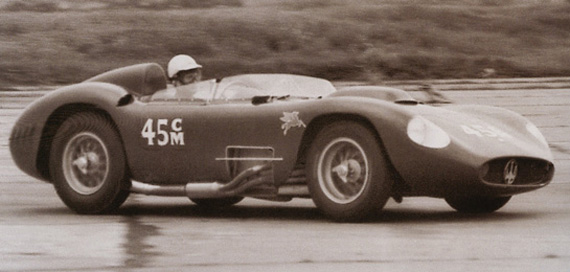
From Volume 1: Galveston Island, April 19-20 1958. Ebb Rose in the 450S, chassis 4509, purchased from CSSCI. His main competition was E.D. Martin in the Ferrari 315S. Rose won both features.
However, what Oosthoek has happily also accomplished was to research and record the history of 62 Ferrari, 47 Maserati and four OSCA sports racers in the south from 1957 through 1962. (See below for complete list) A Maserati historian, Oosthoek’s goal was to uncover actual racing histories of the 300s, 450s, and Birdcage Maseratis and along the way he did the same for the sports racing Ferraris and OSCAs. Taken from that perspective, the three volumes constitute previously unknown histories of Italian sports racers of the 50s and 60s.
___________________
Praise for Volume 3. Thanks for including my old photos and publishing them – it will be appreciated in my family for years to come. With these books, I think you really captured the era and the aura of people who participated – it jumps off the page & takes one back to those times & places. Kudos! -Benita Lane
___________________
Oosthoek researches events at venues such as Stuttgart (Arkansas), Dunnellon Park (Florida), Auburn (Alabama), Eagle Mountain Frostbite (Texas), Oklahoma Petite Prix (Oklahoma), Carrera del Alamo (Texas) and Jim Hall’s home track at Midland (Texas). Well, now you know why the results were pretty obscure. To ferret out the information, he contacted local libraries who were very helpful in finding newspaper reports and results from more than a half century ago and interviewed a huge number of mechanics, wives, owners and drivers from the era. Each event is given a chapter, some have dozens of photos, a few have only one to two, but each is provided with a list of finishers, and all serial numbers are noted as possible.
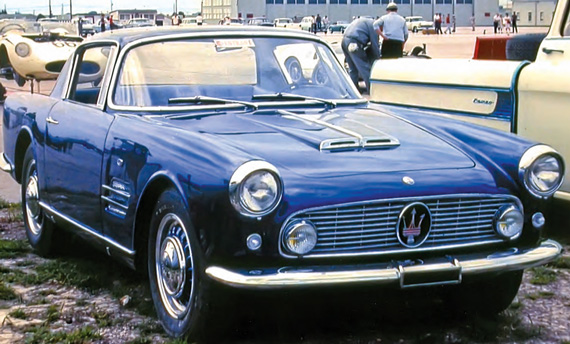
From Volume 2: Jim Hall drove Maserati off track as well. This is his personal Allemano-bodied 3500GT at San Marcos, Texas in 1960.
In search of Maserati history
A retired banker and author of several books on Maserati, Oosthoek has a desire to see that the cars he has chronicled—in particular the 450 S and Birdcage Maseratis—are given their just due. At the same time, he is particularly hard on historians and car owners who claim victories their cars never won. In fact, it was this search for the truth that was the prime motivator for the creation of this series of books. It became a quest for information, most of which has been badly neglected in terms of the sports car racing scene from Texas to Florida in the mid-fifties.
The lack of factual information about these events—they were rarely covered in newspapers, auto magazines or in many cases, not even the SCCA club magazine, created a vacuum that could be filled with pure speculation posing as historical fact. According to Oosthoek, “As a result, in recent years much disinformation has been published with sometimes perplexing claims about who won which Southern event in what car.” This lack of press coverage didn’t extend to Sebring. Although the FIA 12 hours of Sebring was not an SCCA event, it was in the Florida Region and Oosthoek includes coverage of the Enduro in each year.
Readers must be advised that unlike the relatively complete race results that appear in Terry O’Neil’s books, that the race reports do not provide a full result schedule (in boxes) for the production classes. Oosthoek explains: “The text covers all individual races with their overall and class winners from Novice Races to the Feature. However, rather than include the individual results schedules for each and every weekend race, often with unknown amateurs at the wheel of production cars, the decision was made to reserve the schedules for the modified races.” He adds that the information on production classes was even sparser than the modifieds. In other words, we are lucky to have what we have.
___________________
Wow, having fun all over again! Volume 3 came yesterday, got up at 4:00, what a beauty! Just taking a pit stop to say you are leading the race! -Willis Murphey Jr.
___________________
Personal anecdotes
Oosthoek was able to make use of a considerable amount of information provided via personal interviews with many of the participants of the events covered. With access to many of the original players, Oosthoek gives the story a human side rarely if ever seen in print. Between the stats and photos, are nuggets of personal information which brings these years alive.
Although a lot of the racing in the South was fueled with Texas oil money, Oosthoek finds all sorts in the drivers’ seat. Dick McGuire, Harry Rollings and David Lane were in the medical field, E.D. Martin owned a chain of theaters, A.D. Logan supplied Safeway with fruits and veggies, Bill Fuller was in the lumber business. Ebb Rose ran a trucking business. This was a cross section of America in 1957 and 58; all powerful, omnipotent, and above all else, wealthier than any other country at any other time in history. At the same time, there was strange dichotomy; according to Michael T. Lynch, “Those who bought foreign cars were viewed with suspicion by many Americans. Just as they assumed we were the greatest country in the world, no questions asked, they could not understand why one would want something that was naturally inferior, because it wasn’t American.” It was perhaps part of the reason sports car racing, as successful as it might have been, did not replace baseball.
Maserati in motion
Focusing on Maserati was one of the main goals of the project but it is a happy coincidence that many of the major players were driving Maseratis. From the A6GCS 1659 to the last of the Tipo 61s, Maserati was a mainstay of the primary teams such as Jim Hall and Hap Sharp. But the Trident was there in 300S, 200S, 150S, 450S, Birdcage and even the later dying years of the amateur series with Hap Sharp’s Maserati engined Coopers.
The series begins in with the 1957 season; there were events prior to that year but with few really good machines. For the 1957 season, the 2 and 3 liter Ferraris and Maseratis tended to dominate the racing. But by 1958, the decision by the FIA to put a limit of three liters for the 1958 season was a windfall for American buyers. The monsters built in 1957—in particular the Ferrari 315S and 450S Maserati—were now free to be brought into the U.S. by small businesses such as Hall’s CSSCI, which became a Maserati distributor. In 1959 and 1960, the big iron from Italy showed their heels to almost everything that could be thrown at them.
By 1961, aside from a few races run by Jim Hall and the 450S, the day of the big front engined Ferraris and Maseratis that had previously dominated the Southern region was over. Jim Hall entered 450S in a few races, but by the end of the year he was ready with his first Chaparral. The Maseratis were still in play but now were the Tipo 60 and 61 models, raced by Hall, Roger Penske, and Alan Connell.
The Ferrari-Maserati, or Maserati-Ferrari
Connell had two Birdcages, and with one named Ol’ Blue, created a hybrid never seen before in the annals of Italian cars…a Ferrari engined Maserati. Oosthoek’s description of this illustrates the kind of Serial Number information that is found throughout the three works…again reiterating the fact that this is more than just a compendium of race results. Throughout the three volumes, Oosthoek deftly records which Ferraris and Maseratis had engine changes, and what happened to the original engines and chassis.
___________________
Comments on Volume 3. Thanks so very much for the new book. I stayed up late Saturday night going through the photos and captions. Sherri kept yelling for me to come to bed. “In a minute, In a minute….” – David Jones
___________________
In general, those final years before SCCA created the USRRC pro series also witnessed the demise of the front engine sports racers, including the Scarab, Lister Jags and Chevys, Hall’s own Chaparral I. This was surprisingly heralded not by mean rear engined cars powered by Fords or Chevys, but by cars like the Climax engined Lotus 19 and the Cooper Monaco, powered by both a Climax and in the case of Hap Sharp’s successful Monaco, by a Maserati engine.
Oosthoek being Oosthoek, along with the backing and of Glyn Morris at Dalton Watson, created a superb series of indexes to accentuate his research and at the same time made these books a valuable reference source. In addition to identifying major cars by serial number in the text and in the captions, after each year he lists “Identified Sports Racers Campaigned by Privateers around the South” and includes Ferrari and Maseratis with chassis number, model, owner and driver. Then source material and a map of the U.S. with locations of each event covered. Next, an index by car–and by model. After this, an index of car chassis. There is an index for Media while another index lists “Other” and yet another lists “People”.
And without further ado, here is the list of Ferrari, Maserati and OSCA serial numbers of the cars which are mentioned, listed, and or photographed in the three volume set.
Ferrari Sports Racers
0068, 0100, 0202, 0260, 0262, 0348, 0370, 0376, 0392, 0396, 0446, 0454, 0496, 0498, 0502, 0510, 0518, 0532, 0538, 0554, 0592, 0596, 0598, 0600, 0614, 0622, 0626, 0642, 0650, 0652, 0654, 0656, 0658, 0662, 0664, 0668, 0672, 0684, 0686, 0714, 0720, 0722, 0724, 0730, 0732, 0746, 0748, 0752, 0756, 0764, 0766, 0768, 0770, 0774, 0776, 0778, 0784, 0790, 0792, 0794, 0796, 0806
Maserati
1659, 2186, 2401, 2405, 2412, 2414, 2418, 2419, 2421, 2422, 2423, 2424, 2425, 2426, 2427, 2427, 2430, 2431, 2432, 2451, 2453, 2455, 2456, 2457, 2458, 2459, 2461, 2463, 2464, 2468, 2470, 2471, 2472, 3051, 3052, 3054, 3068, 3071, 3073, 4504, 4506, 4508, 4509, 4510, 001, 002, 006
OSCA
1145, 764, 1183, 1001
While in the larger order of things, it matters very little who won an obscure airport event in Alabama over a half century ago, when cars cease being mere race cars but cultural art artifacts worth millions of dollars, the value of the provenance rises to the occasion. Thus, the Willem Oosthoeks of this world play an important role in establishing said history. And while some might think tracking such trivia is akin to researching batting averages of minor league baseball players, Lynch reminds us that “Professional historians like Barbara W. Tuchman and David McCullough skim the historical cream for popular reading, but the people we know fill in the details. This is the case in documenting all forms of human endeavor.”
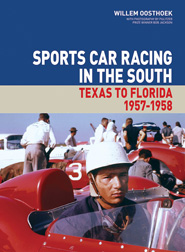
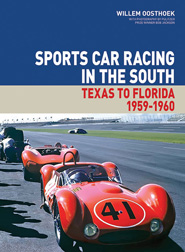
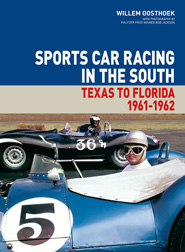
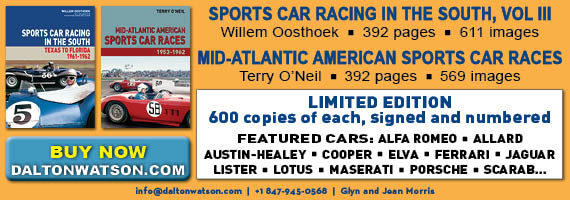
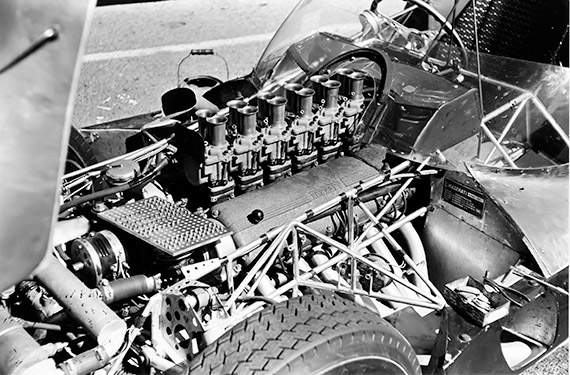
Thanks for getting all of this together, so we all have a record of what we did
back then! This will be around forever for our families to relive forever;the
beautiful pictures you’ve collected; and great detail. Thank You!
Nedra Ware
Wow what a set of books ! Willem is the man ! Mind boggling project to undertake much less finish.
A couple of years ago, in a Clovis, CA antique shop I found a participants dash plaque for the 1959 SCCA Gulf Coast Region DOTHAN ALABAMA RACES. I bought it. Dothan was my “home town” 1956-60 when I attended Auburn University to study electrical engineering. I was a “sports car nut” then (still am) but I never knew of this race until I found this dash plaque. I sure wonder how the plaque ended up in the city where I now live over 60 years later. This article also mentions races at Auburn, AL but doesn’t give a date. I was not aware of any races while I attended Auburn 1956-60 but there were a lot of sports cars there.
I remember a ex-Olympian wrestling coach with a new red Porsche Speedster and I had a math professor with a TR2. In those years there were a number of ‘older guys’, most in their late 20’s, returning to Auburn after the Korean war had interrupted their education and several brought back sports cars including multiples of MG’s, Porsche’s, Alfa’s, Triumph’s and one Berkley. In fact, my first rally was a 12 hour event put on by the Auburn Sports Car Club. It began at mid-night with a staggered start and ended at noon the next day . There must have been 50 participants. The route included a 2 or 3-car ferry crossing a river which buggered up the works. I was the navigator in a friends new ’59 MGA and saw a lot more of my slide rule than I did of the country side! When you meet participants coming at you from the opposite direction, you begin to wonder “who’s right?”. A lot of cars got lost and didn’t finish. I remember one participant, a doctor from Columbus, GA, in a new blue Ferrari. His son was the navigator and had a most impressive clip board with 3 Heurer stop watches. That sure impressed me as navigator using only a wrist watch! I figured they would win hands down. However they got lost and I never saw the car again. We finished 2nd over all!